How to use Sensory Books for Speech Development
How to use Sensory Books for Speech Development
Sensory Books for Speech Development are great speech and language-building tools. Children find them engaging and captivating. Sensory books offer many opportunities for open-ended play. Read more on Sensory Books here.
Here are some ideas to use them with children.
Babies and young toddlers
The focus here would be on activities which improve basic sensory awareness. For this child, we can plan a book which is colourful and has a lot of textures. Let the child feel these textures and understand the differences. This is a wonderful time to also introduce vocabulary to the child in terms of the colours that they see or the textures that they feel. Let them feel soft, hard, smooth, rough, wavy, grainy, squishy etc.
In addition, some other activities could include feeling the texture of bubble wrap and trying to burst the bubble in the bubble wrap. If the child is a little older, you could make some homemade slime and let the child play with that. Using play dough at this stage is also a good idea. In both these conditions, the child would need to be very well supervised so that they don’t put anything in their mouth. If there is a fear that the child would ingest the slime or play dough, you can also consider putting it in a zip lock cover or balloon and then let the child play with it. Even something as simple as putting some flour in a balloon and tying it up would give the child the squishy sensation.
Toddlers and Young Children
At this stage, we can introduce those activities which would not only improve the child’s language but are also aimed at improving the child’s gross and fine motor skills. With a sensory book, we would be aiming at improving the child’s fine motor skills. These include fixing or removing items with velcro, use of buttons, clothespins, zippers, tying ribbons/ shoelaces, braiding hair and weaving.
The language-based activities that could be introduced in this age group include body parts (through the potato head activity), some occupations (through the change of dresses), routine-based activities like brushing teeth, combing hair, bathing, eating; counting, animals, colours, vehicles, vegetables and shapes.
Older Children
Older children are beginning to think and reason. To develop this skill, activities which improve problem-solving can be introduced to the older child. For example, in one of my books, I have made a matching activity where the child needs to match the sense with what it is responsible for. These children might also be able to work out complex puzzles. Puzzles where they need to put together a picture or where they need to put together smaller shapes to make a bigger shape like a square (explained with a representational image in the picture below).
Some basic mathematics can also be introduced in the book. In my example below, I also have two palms with fingers that can be folded. This can help the child through the simple addition and subtraction. The child can also be taught to tell time with a clock where the hands can be turned and the parent can teach and quiz the child about time. In one of my books, I have also introduced the concept of saving money with a piggy bank and a page on the popular game tic-tac-toe.
Language-based activities can also be included for the older child. Here the focus would not just be to introduce higher level vocabulary, but also helping children form sentences. Story based activities can also be carried out. Some new concepts can also be introduced like gardening, weather etc. I have made a mailbox page in one of my books where the mailbox opened with two envelopes inside with notes for the children that I made the book for. However, the same envelopes can be reused by the child to write simple notes for the members of their family. This would also encourage the child to do some basic writing. Although technology has changed considerably, I remember as a child how I enjoyed playing postman!
Books for Speech Development
Books for Speech Development
Simple versions of these books could be made at home with paper or felt and some glue.
This is a guest blog post by Shruti, The Arsty Audiologist. Subscribe to Shruti’s channel here!
- Speech Therapy Activities for Ganesha Chaturthi - September 6, 2024
- 5 Ways to Help Your Child’s Language Development - August 31, 2024
- Epilepsy – Myths and Facts - August 20, 2024

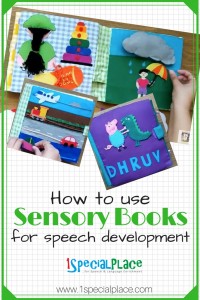
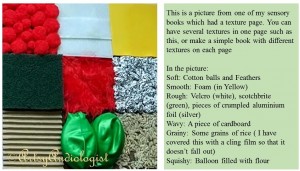
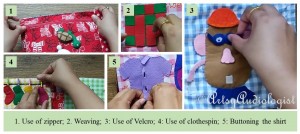
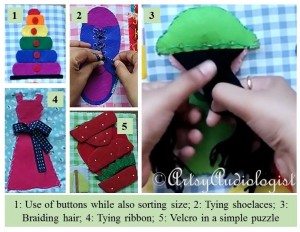
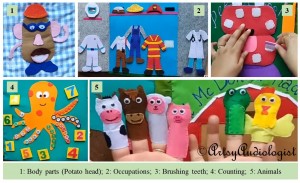
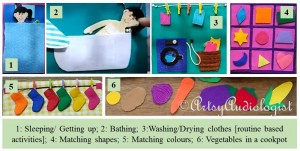
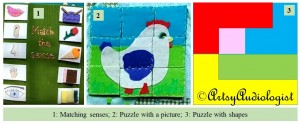
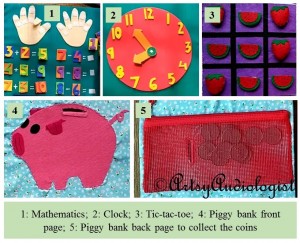
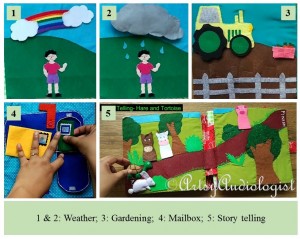
Leave a Comment
(0 Comments)